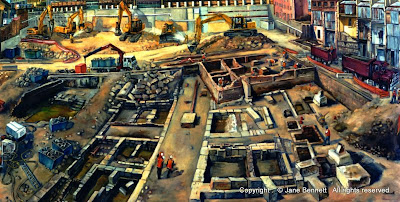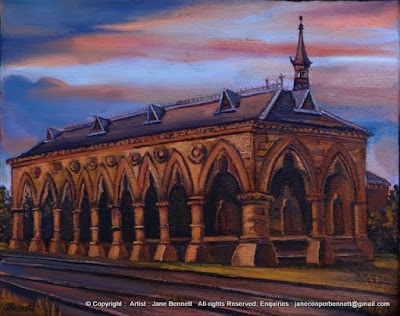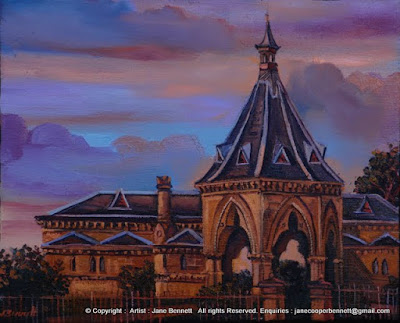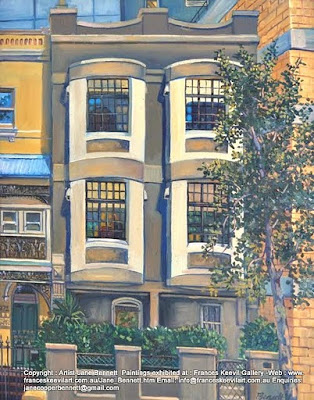The K.E.N.S. Site 2003

'K.E.N.S. Site-the archaeologists"
2003 oil on board 32 x 67cm
Enquiries
Before Barangaroo, there was the K.E.N.S. Site.
"K.E.N.S." , the acronym for "Kent, Erskine, Napoleon and Sussex streets", was next to "Morton's Hotel". This historic wharfie pub, formerly known as the "Big House" by local dockies, has now been renovated and reinvented as the "Sussex Hotel" in an attempt to curry favour as a watering hole for the new upmarket residents expected when the Barangaroo development kicks in.
This painting shows a troupe of archaeologists in a frenzy to complete their digging and notetaking before the excavators remove all the ruins.
Archaeologists remind me of seagulls.
On ruins and rubbish tips they settle in vast flocks, squabbling over unpromising bits of debris until chased away by the developers.

"K.E.N.S Site-the Mack truck"
2003 oil on board 32 x 65cm
Enquiries
Here the convict-cut sandstone blocks are mashed up and put into the back of a Mack truck before being dumped into the sea as part of the Port Botany expansion.
Some of these ruins dated from before the 1820s- so this painting commemorates one of the great crimes against Sydney's built environment.
Sadly, just one of so many.

"K.E.N.S. Site-the Erskine st. terraces" 2003
oil on board 20 x 40cm
Enquiries
At first I had thought that these attractive terraces would be swallowed up in the demolition frenzy, but they were retained and renovated.

" K.E.N.S.Site-Excavation by the terraces" 2003
oil on board 40 x 20cm
Enquiries
They are now only able to be viewed from the Erskine Street side now, as the space to the back is now covered by the new Westpac headquarters.

"Erskine St terraces, K.E.N.S. Site" 2003
oil on paper 56 x 76cm
Enquiries
Another view of the Erskine St terraces.

"Archaeologists at K.E.N.S. Site"
2003 acrylic on paper 64 x 67cm
Enquiries
The older the stonework, the better the quality of the carving.
"K.E.N.S. Site-the Archaeologists "
2003 ink on paper 76 x 110cm
Enquiries
Before its excavation, this block of land was the site of a 1940s service station. Under this layer was a late 19th century brick building. Below this was a labyrinth of beautifully quarried sandstone blocks, which mostly marked the drainage system. There were also a series of stone steps, which can be seen clearly at the far left hand side of this drawing, that were remnants of one of the first fingerwharves of this historic precinct. These could have dated from as early as 1805.These steps must have roughly coincided with the original shoreline. They were halfway between Kent and Sussex Street - so anything west of Sussex Street is fill.

"K.E.N.S. Site panorama" 2003
oil on canvas 91 x 183cm
Enquiries
A grand panorama showing the whole site's development from my makeshift studio on the Sussex St hoardings. Below me the Leighton's project managers get their shiny new metal capped boots dirty as they inspect the excavations.In the background is the complete collection of boy's toys. Diggers, munchers and pulverizers jostle for position as they are hosed to keep the dust down.
Soon after I painted this epic canvas Bob Carr made his historic announcement that "Sydney will always be a Working Harbour".
So naturally I knew it was doomed.
I then begged, coaxed and pleaded my way into becoming the Hungry Mile's "Artist in Residence".
The rest as they say is history.
A.G.L. Gasworks, Mortlake 2004
to Breakfast Point 2007

Winner: 2011 Cliftons Sydney Art Prize
Collection : Cliftons
Enquiries
Opened in 1886, the A.G.L. Gasworks boasted grandiose structures and a huge workforce. When coal gas technology became obsolete 100 years later the sprawling 58 hectare site became a bizarre and derelict wasteland. Where once 6 retort houses had continually burnt coal from Newcastle to light Sydney’s streets all that remained was a skeletal roof and more buttresses holding the crumbling walls up than there were actual walls.
As the coal tar waste was removed from the site, 40 metre chasms were dug into the glowing sandstone escarpment surrounding the C.W.G. Building.
The initials C.W.G. stand for Carburetted Water Gas- not Carbonated water and gas as I had previously thought, which sounded like something to do with "Coca-cola".
I had to attach notes to my easel reminding me not to walk backwards to admire my work or my stay would be short and painful.
After rain some of these channels would fill with water, becoming a network of lakes reflecting the ruins.
A suburb is reborn - 'Breakfast Point'
The ‘lost’ civilization of the Industrial age is only a paltry century or so ago, instead of a couple of millennia, yet the history and purposes of its buildings are already almost incomprehensible to most of the new inhabitants.

Enquiries
I was lucky enough to witness the demolition of the CWG building.The developers laughed at me for drawing instead of taking photos. Digital cameras weren't reliable or easy to use then, and their brand new digital camera didn't work. I completed 8 detailed ink drawings that day, one of which I later had the pleasure of selling to them.
Later I was asked to hold a solo exhibition in the newly built Community Hall to open Breakfast Point. The road had only been named the week before and my clients got hopelessly lost trying to find it .
Instead of a simple record of appearances, I wanted to convey the feeling of being inside a vast and ancient monument that dwarfs the normal human scale. In common with the ruins favoured by the 18th century artist Piranesi, the CWG site of Mortlake is a decayed and vandalized relic of an earlier civilization. All that remains is a skeletal roof and more props holding the crumbling walls up than there are actual walls. The crazy zig-zag of the diagonal buttresses adds to the apparent instability of the structure, which no sane architect would dare restore.
I was influenced by Piranesi’s etchings which used every trick of perspective to transform prosaic renditions of Roman ruins into hallucinatory visions of frustration and oppression. I have exploited chiaroscuro by using dramatic contrasts of light and shade to destroy the rationality of Classical architecture and intensify the power of the forms until they become a source of dread and melancholy.
View my 'AGL Gasworks, Mortlake' page
Carleton United Brewery 2009
A pub with no beer (or walls, or roof)

"Pub with no beer, Carleton United Brewery"
2009 oil painting on canvas 75 x 100cm
Enquiries

"Pub with no beer, Carleton United Brewery"
2009 oil painting on canvas 100 x 75cm
Enquiries
Dig this : A little amateur archaeology

"Archaeological relics of the dig"
2009 oil painting on canvas 61 x 61cm
Enquiries
I met one of the drill rig team later at Barangaroo.
Chippendale- Mortuary Station
Mortuary Railway Station on Regent Street, Chippendale was designed by James Barnet in the Victorian Free Gothic architectural style and opened on 29 June 1869.

CH8 "Mortuary Station, evening from Regent st"
2009 oil on canvas 41 x 51cm
Enquiries
Originally funeral trains bound for Rookwood Cemetery departed from Mortuary station.
There are still vestiges of its sister station remaining at Rookwood.

CH6 "Mortuary Station, evening"
2009 oil on canvas 20 x 25cm
Sold
PRIVATE COLLECTION : SYDNEY
Enquiries
By 1938 it was used as platform for horses and from 1950 onwards it was just used for parcels.
CH7 "Mortuary Station, evening"
2009 oil on canvas 20 x 25cm
Sold
PRIVATE COLLECTION : SYDNEY
Enquiries
Ballast Point

Enquiries
A view of Ballast Point from the knuckle of the East Darling Harbour Wharves, now called Barangaroo.The original Tank 101, built in the 1930s, was the largest industrial storage vessel at this site, used to store crude oil for processing into lubrication oil. It was the largest tank in Australia to use rivet technology.
Transformation of the site started after the state government bought the land in 2002, announcing it would become a public headland park.
It was then placed in the hands of the Sydney Harbour Foreshore Authority, but there was a lengthy and bitterly fought battle by residents to stop development on the site and an equally bitter battle by Lang Walker’s Walker Corporation for compensation after he bought an option to develop the site.
Now, at the newly created Ballast Point Park, the complex of tanks have been replaced by the cylindrical skeleton of a former giant oil tank standing sentinel on the headland.
"Tank 101", a sculpture created as both artwork and renewable energy generator containing eight wind turbines, symbolises the past working history of the site as the Caltex oil refinery.
Panels of curved sheet steel from the old tank have been rescued from the old tank and incorporated in the structure, which has been punctured with holes forming the words of poet Les Murray: "Stone statues of ancient waves, tongue like dingoes on shore.".
Debris leftover from the demolition of the tanks at the new park has been stored behind the White Bay Power Station.
Hopetoun Hotel, Surry Hills 2009

"The Hopetoun Hotel, Surry Hills"
2009 oil painting on canvas 56 x 76cm
Enquiries
The Hopetoun, a well-loved old warhorse of the live music scene, was abruptly closed down in 2009 after a few stoushes with the council about fire and noise regulations.
"The Hopetoun Hotel, Surry Hills"
2009 ink & charcoal painting on paper 100 x 132cm
Enquiries
I worry about the old Hoey becoming another "White Bay Hotel".
"The Hopetoun Hotel, Surry Hills"
2009 oil painting on canvas 56 x 76cm
Enquiries
New life had been temporarily breathed into the old pub. In early August 2012 it was used for a film shoot in a new Hugh Jackman movie.Summer Hill

Summer Hill Mungo Scott Flour Mills Last Flour truck
2004 oil painting on canvas 41 x 61cm
Sold
PRIVATE COLLECTION : SYDNEY
Enquiries

"Summer Hill Mungo Scott Flour Mills Evening"
2009 oil painting on canvas 31 x 31cm
Sold
Enquiries

'Summer Hill: Mungo Scott Flour Mills Panorama'
2009 oil painting on canvas 91 x 122cm
Sold
Enquiries
Victoria Street Terraces
In December 2009 I was asked by some of the people working at St Vincent's if I could record the terrace houses next to the Garvan Institute close to St Vincent's before they were demolished in early 2010. St Vincent's wanted to extend its empire, and almost an entire block was destined to bite the dust to be replaced by buildings that would physically resemble the Victor Chang Centre that loomed behind it.

V4 Victoria st terraces-The RMO 2009-10
Ink,gouache on paper 63 x 41cm
A breakthrough 11-storey medical centre is now being built on the Darlinghurst site, which will customize patient treatment instead of the one-drug-fits-all approach which doesn't always work. The new Kinghorn Centre, which opens in June 2012 is a joint Garvan Institute and St Vincent's Hospital project.
The buildings to be demolished were a motley collection, ranging from the charming, to the quirky, to the downright hideous. Some of them had heritage value, but all had been compromised to a greater or lesser extent by tasteless modern extensions. But put together, they expressed the character of a very colourful area of Sydney street-life, in a way that will be lost when the new medical monolith has replaced them.
 |
| 'Victoria st terraces Nos.372-4 - The Diabetes Centre and the R.M.O. Headquarters' 2009 oil painting on canvas 51 x 41cmSold Enquiries about similar paintings |
The initials "R.M.O." stand for Resident Medical Officer, and this building was used for accommodation.
 |
| Victoria st terraces-The RMO HQ 2009-10 oil painting on canvas 46 x 36cm |
Enquiries
This building reminded me of some early 20th century Jugendstijl architecture that I saw in Vienna and Berlin, with its strangely curved architraves that gave the barred windows an over-emphatic, top-heavy look.  |
| 'Victoria st terraces-Diabetes Australia' 2009 oil on canvas 31 x 31cm Sold |
Enquiries about similar paintings
The buttercup yellow Diabetes Centre next door, appropriately enough, had a chocolate box sweetness in comparison to its heavy-browed neighbour.  |
| Victoria st terraces - Mural and clinic 2010 oil painting on canvas 31 x 41 cm Enquiries |
The silver grey steel and glass blocks of the Victor Chang Centre loom behind the mural - a harbinger of the future.
 |
| Victoria st terraces-The Mural 2009-10 Ink,gouache on paper 43 x 61cm |
Enquiries
Between the clinic and the Green Park Hotel at the end of the block was a naively painted yet heart-felt lime green mural, a tribute to World Aids Day. I have seen scaffolding around this area recently, and at first I thought that there was a possibility that this mural would be retained. This turned out not to be the case, so I'm glad that I painted this in several works.
I was originally commissioned to paint just the R.M.O building, but as I set up over the road and started to paint, a steady trickle of people from the clinic, the Diabetes Centre and other workers and residents of the area started to beg and coax me into painting more and more of the surrounding area.
'Victoria st terraces' Enquiries
This canvas shows the entire block, from the R.M.O. on the extreme right, to the Green Park Hotel on the left.
 |
| V12 'Panorama of Victoria st from 'Sel et Poivre' De Lacey wing' to the Green park Hotel 2011 oil on canvas 25 x 153cm |
Enquiries about similar works
Although I must say that I did actually end up leaving my paint, canvases and even handbag lying around unattended quite often, and although my paintings did end up attracting a few admirers, none of my belongings were ever touched. One of the clinic's clients even did me a favour by scaring off a parking ranger who had been complaining about the irregularity of me sitting at my easel and painting the view.Now several of my paintings from this series have been acquired by medical staff and will find a home in various clinics in the new Centre.
Dunlop-Slazenger factory in Alexandria

"Fibro Yeha! panorama" 2015 oil on canvas 91 x 183cm
Enquiries

"Soda panorama" 2015 oil on canvas 91 x 183cm



No comments:
Post a Comment